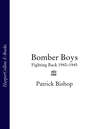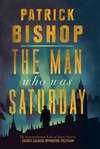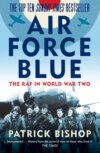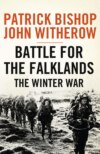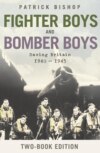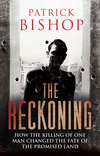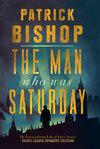Buch lesen: «Bomber Boys»
BOMBER BOYS
FIGHTING BACK
1940–1945
PATRICK BISHOP

Copyright
HarperPress
An Imprint of HarperCollinsPublishers
77–85 Fulham Palace Road,
Hammersmith, London W6 8JB
Patrick Bishop asserts the moral right to be identified as the author of this work
A catalogue record for this book is available from the British Library
Plans of Halifax and Lancaster bombers © Copyright The National Archives.
Plans of Stirling, Mosquito and Wellington bombers
© Crown Copyright RAF Museum
Maps of Cologne and Berlin © Copyright Royal Geographical Society.
Maps of Bomber Command Stations, Targets in Europe, Germany,
and the Ruhr Valley by John Gilkes.
All rights reserved under International and Pan-American Copyright Conventions. By payment of the required fees, you have been granted the non-exclusive, nontransferable right to access and read the text of this e-book on-screen. No part of this text may be reproduced, transmitted, down-loaded, decompiled, reverse engineered, or stored in or introduced into any information storage and retrieval system, in any form or by any means, whether electronic or mechanical, now known or hereinafter invented, without the express written permission of HarperCollins e-books.
HarperCollinsPublishers has made every reasonable effort to ensure that any picture content and written content in this ebook has been included or removed in accordance with the contractual and technological constraints in operation at the time of publication.
Source ISBN: 9780007189861
Ebook Edition © MARCH 2011 ISBN: 9780007280131
Version: 2014-09-17
Contents
Cover
Title Page
Copyright
Dedication
Maps
Prologue: Perkins
Introduction
1 Learning the Hard Way
2 Coventrated
3 ‘To Fly and Fight’
4 Crewing Up
5 Dying in the Dark
6 Enter ‘Butch’
7 The Feast of St Peter and St Paul
8 The Reasons Why
9 The Battle
10 A Select Gang of Blokes’
11 The Big City
12 The Chop
13 Crack Up
14 Home Front
15 Love in Uniform
16 D-Day Diversion
17 Tallboys and Tirpitz
18 Götterdämmerung
19 Forgetting
Epilogue: Went the day well?
Keep Reading
Notes
Bombers
Index
Acknowledgements
About the Publisher
To Peter, Margaret, Amelia
and Daniel
Maps






Prologue: PERKINS
In the early summer of 1961, sophisticated Londoners were laughing at an entertainment brought to them by four young Oxbridge graduates. Beyond the Fringe had been a great hit at the Edinburgh Festival the previous year. Now, night after night, smiling audiences in the capital left the Fortune Theatre feeling they had witnessed something fresh, audacious and above all very funny. The excitement that comes with the anticipation of sudden and unpredictable change was in the May air. The old, hierarchical Britain personified by the prime minister, Harold Macmillan, appeared to be tottering to an end. The shape of the future was hard to make out but it surely belonged to the young, the daring and the irreverent. Alan Bennett, Peter Cook, Jonathan Miller and Dudley Moore were the incarnation of all that.
One of the sketches was called ‘Aftermyth of War’. It made fun of legends created during wartime and already planted deep in Britain’s consciousness. There was quite a list. It mocked Neville Chamberlain and his ‘piece of paper’, stoical working-class Londoners and the Blitz spirit and even the Battle of Britain. Then it was the turn of the men who flew in the aeroplanes that bombed Germany.
The sequence opens with Peter Cook, in the uniform of a senior RAF officer, entering to the sound of airmen singing heartily around a piano.
COOK: Perkins! (Jonathan Miller breaks away from the singing.) Sorry to drag you away from the fun, old boy. War’s not going very well, you know.
MILLER: Oh my God!
COOK: … war is a psychological thing, Perkins, rather like a game of football. You know how in a game of football ten men often play better than eleven?
MILLER: Yes, sir.
COOK: Perkins, we are asking you to be that one man. I want you to lay down your life, Perkins. We need a futile gesture at this stage. It will raise the whole tone of the war. Get up in a crate, Perkins, pop over to Bremen, take a shufti, don’t come back. Goodbye, Perkins. God, I wish I was going too.
MILLER: Goodbye, sir – or is it – au revoir?
COOK: No, Perkins.
The last lines got one of the biggest laughs of the night. In the stalls, sitting with his wife Margery Baker, Tony Iveson tried to laugh along with the rest. They both worked in the new world of television and were part of the emerging Britain. But not very long before he had been Squadron Leader Tony Iveson DFC of 617 Squadron, and at the front of the bombing war. ‘I didn’t like it,’ he said forty-four years later. ‘I remember being upset. I probably wouldn’t be now but at the time it seemed unnecessary, in view of how many we lost.’1
Of the 125,000 airmen who passed through Bomber Command during the war, about 55,000 were killed. Twenty-one of them were called Perkins. The first to die was Flying Officer Reginald Perkins of 54 Squadron who was killed on the night of 14/15 November 1940. He was the pilot of a Hampden which took off from Waddington in Lincolnshire to bomb Berlin. Little is known about his death or those of his three crew mates. Their aircraft is ‘believed to have exploded in the air and crashed on the outskirts of Berlin’.2 The last to die was Flying Officer Robert Perkins of 49 Squadron, the pilot of a Lancaster who was killed with the rest of his crew while bombing the Lutzkendorf oil refinery on the night of 8/9 April 1945, a month before the end of the war in Europe.3 Nothing at all is known about how they were lost.
As far as I am aware, no Perkins died bombing Bremen, but one might well have done. From 18 May 1940 until the end of the Second World War it was attacked some seventy times. As a result, about 575 aircrew were killed. So too were 3,562 residents.4 It is this aspect of Bomber Command’s war, the death of German civilians, that has preoccupied historians in the years since the Beyond the Fringe sketch. All the myths that were the butt of its jokes have since been re-examined and turned out to be remarkably resilient. It is Bomber Command’s reputation that has suffered the most. Re-evaluations have found the crews’ efforts to be at best misdirected and at worst little better than war crimes.
This last accusation is false and insults truth and justice. Bomber Command, as I have said, attacked Bremen frequently. The first bombs killed thirteen people. They also burned down two warehouses full of furniture confiscated from Jews who had understood what fate awaited them in Germany and fled. Bombers were busy over the city on the night of 17/18 January 1942. Only eight of the eighty-three aircraft dispatched found the target and little damage appears to have been done. The Nazi newspapers in the days following denounced the raiders as ‘terror fliers’. As they did so, sixteen Nazi bureaucrats met on 20 January in a villa at Wannsee outside Berlin to co-ordinate the extermination of the entire Jewish population of Europe.
The Nazis were to good as a black hole is to light. The effects of British and American bombing on Germany and the lands the Germans conquered were dreadful and it is right that they should be recorded and remembered. But the Allies’ real crime would have been to hold back from using any of the means at their disposal to destroy Hitler and those who sustained his war.
The argument over exactly what Bomber Command achieved will never be settled. One undeniable success, an awkward one to acknowledge nowadays, is that it altered Germany’s personality. Saturation bombing may not, as intended, have broken the Germans’ spirit. But it helped powerfully to bring about their post-war conversion to peaceful democracy.
History in its current mood has paid limited attention to the ethos and character of the men who fought this most extraordinary war. This book sets out to correct that imbalance. It is for, and about, Perkins. In the process I want also to redress a wrong. There is no national memorial to the men of Bomber Command, no one place where their sacrifice and contribution to victory are properly and thankfully commemorated. I hope that Bomber Boys will mark a first step in changing that.
Introduction After the Whirlwind
No one who saw what Allied bombing did to Germany forgot it. A traveller in an official delegation passing through Berlin two months after the German surrender noted in his diary: ‘Berlin … is ghastly. I could never have believed how complete the destruction is. We covered [about five miles] and saw less than a dozen undamaged houses and not one in ten was anything more than a burned-out shell.’
Soon afterwards he visited Potsdam, less than twenty miles to the west. ‘Bert Harris removed the town of Potsdam in half an hour one night in April,’ he wrote. ‘I have never seen anything so complete … the usual procession of handcarts, prams etc. and the same slab-faced people as in Berlin.’
The sight, he felt, was the finest possible lesson to the Germans of the folly of initiating wars. Yet he ‘came away feeling very sorry for these people and when I eventually said so I found all the others felt just the same.’1
The man who wrote these words had played a central part in creating the scenes he witnessed. He was Marshal of the Royal Air Force Sir Charles Portal, who as Chief of the Air Staff had overseen the bombing campaign. ‘Bert Harris’ was his subordinate, Air Marshal Sir Arthur Harris, the head of Bomber Command who had put Allied strategic theories into devastating practice.
A little afterwards, a veteran pilot who had taken part in many of the raids flew over some of the areas he had bombed. ‘It was a fine clear day and we flew at 4,000 feet,’ wrote Peter Johnson, ‘a good height for an overall view and we saw as we passed something of what had happened to, amongst others, Hamburg, Lübeck, Hanover, the Ruhr towns, Cologne, Aachen and Düsseldorf and so south to Stuttgart, Nuremberg and Munich … the general devastation was almost unbelievable. In town after town hardly a building seemed to be intact, hardly a house seemed to be habitable. All that showed from the air were rows and rows of empty boxes, walls enclosing nothing … the whole area was, for the time being at least, dead, dead, dead.’
Johnson could not help wondering ‘whether this truly dreadful sight represented a degree of overkill, whether such destruction had really been necessary to stop the production of arms for the Nazis in the greatest industrial complex in Europe.’ He reassured himself with the thought that even when the Ruhr was encircled by Allied forces the German people ‘were still obeying Hitler’s frenzied calls for resistance to the last man.’2
The debris was to hang around accusingly for years. In March 1949 the American diplomat George Kennan returned to Hamburg where he had served in pre-war days. He visited the large residential districts east of the Alster. ‘Here was sweeping devastation, down to the ground, mile after mile,’ he wrote. ‘It had all been done in three days and nights in 1943, my host told me. Seventy-five thousand persons had perished in the process. Even now, after the lapse of six years, over three thousand bodies were estimated to be buried there in the rubble.’ [The actual number of victims of the raids carried out on Hamburg between 27-30 July 1943 was closer to 40,000 dead.]
These sights demanded reflection, and justification or judgement. The natural response of most of those who planned or carried out the attacks was the same as Portal’s. The Germans, unquestionably, had started it. They had, as Harris predicted in a much-repeated proverb, sown the wind and reaped the whirlwind. Kennan, however, felt differently. For the first time since the war ended, he wrote, ‘I felt an unshakeable conviction that no momentary military advantage – even if such could be calculated to exist – could have justified this stupendous, careless destruction of civilian life and of material values, built up laboriously by human hands over the course of centuries for purposes having nothing to do with this war. Least of all could it be justified by the screaming non-sequitur, “They did it to us.”’3
The debate over the morality of all-out aerial bombardment had been under way long before the strategic air campaign began and would rumble through the post-war years to the present day. But the first reaction of those who gazed across the haunted mounds of rubble that were all that remained of scores of German city centres was simple awe at the destruction that had been wrought. The onlookers thought they knew what a blitzed town looked like. The results of what bombs did were on display in many of Britain’s major cities. But none of them looked like this.
During the war Bomber Command had been a priceless asset to government propaganda, as a symbol of Britain’s resolve and its willingness and ability to take the war to the enemy. Its actions were thoroughly publicized and its pilots and crewmen ranked as heroes. It fought a continuous campaign from the first day of the war to the last, interrupted only by the weather. The enormous effort and the great sacrifice of life this entailed were honoured and the destruction done to the enemy was presented as a vital element in the victory. In peacetime, the wrecked towns and the grave pits filled with the bones of civilians became an embarrassment and the Bomber Boys faded from the official legend. On the afternoon of 13 May 1945 Churchill broadcast his Victory in Europe speech. There was praise for everyone who had contributed to the war effort. But apart from an allusion to the damage done to Berlin, the main activities of the bomber crews were barely mentioned. There were campaign medals for those who had fought in Asia, the Middle East and Europe. There was to be no specific award for the men who had set about dismantling Hitler’s empire from the air.
The public memory of the air war was selective. People seemed inclined to consign the bombing campaign and those who had fought it to the past. The pilots of Fighter Command, however, had a special place in the post-war consciousness. Scores of books were written by them and about them. Men like Douglas Bader, Bob Stanford Tuck and ‘Sailor’ Malan were celebrities. They were The Few and the battle that they fought was relatively short, roughly four months from the beginning of July to the end of October 1940. The men who crewed the bombers were The Many and their struggle went on and on. Of the 125,000 who passed through the fire, only Guy Gibson and Leonard Cheshire won any lasting fame. Gibson had led the Dams Raid of May 1943, a feat of dash and daring, quite unlike the demolition work which Bomber Command conducted every night. Cheshire was known not so much for damaging people as for healing them, in the homes he set up after the war.
Nobody, it seemed, wanted victory to be tarnished by reminders of the methods that were used to obtain it. Harris had a simple explanation for the ambivalence. ‘The bomber drops things on people and people don’t like things being dropped on them,’ he remarked after the war. ‘And the fighter shoots at the bomber who drops things. Therefore he is popular whereas the bomber is unpopular. It’s as easy as that.’4
There was much in what he said. In the United States, which was never touched by aerial bombardment, there was no such uneasiness and the crews of the Liberators and Flying Fortresses were honoured alongside the rest of America’s fighting men and their deeds praised in films like Twelve O’Clock High. The official assertion that Americans were engaged in precise bombing, rather than the area bombing practised by the British, was widely accepted, even though the distinction often meant little to the people underneath.
The strategic air campaign fought by the RAF and the USAAF was a terrible novelty. For the first time, aeroplanes were used in huge numbers against large population areas to smash an enemy’s capacity to make war by destroying its industry and demoralizing its civilians.
The German Blitz of British cities over the winter of 1940–41 provided the campaign’s initial justification. Bomber Command’s subsequent raison d’être was that it was the main means of exerting direct offensive pressure on Germany, within its own territory. At first the crews flew smallish aeroplanes carrying negligible bomb loads and were guided by primitive navigational aids. In the month of February 1942 when Harris took over his men dropped 1,001 tons of bombs. Better aircraft, new technology, cleverer tactics, Harris’s ruthless style and – above all – the courage and skill of the crews, turned the air force into the most potent proof of Britain’s will to win. In the month of March 1945, with Allied troops closing on Berlin, they dropped 67,637 tons and the Americans 65,962. By the end, the hurt the Luftwaffe had done to Britain had been repaid over and over. German air attacks against the British Isles, including those by V weapons late in the war, killed just over 60,000. Estimates of the deaths caused by Allied bombing of Germany range between 305,000 and 600,000. The cities touched by the Blitz were scarred but not devastated. In 1945 Germany’s seventy biggest towns and cities were in ruins and one in five dwelling places destroyed.5
This disproportionality caused very little anxiety at the time. Germany had struck first and deserved the retribution the RAF was meting out. What concern might have been felt at the suffering of German civilians faded in the knowledge of the price the Bomber Boys were paying to deliver this vengeance. It was impossible to hide the losses and the government did not try.
This was a home-front war and civilians along the outbound and inbound routes to the Continent were present at the opening and closing scenes of the action. During the war years the RAF in Britain grew into the most visible of the services. In the bomber station-cluttered east and north there seemed almost as many airmen and-women as there were civilians. ‘By the time I got there Lincoln had turned blue,’ remembered Reg Payne, a wireless operator who was based at Skellingthorpe just outside the city.6
Bomber Command grew and grew as the volunteers arrived in numbers that never slackened even during the darkest hours of its campaign. Behind each man flying, there were many more keeping them in the air. There were fitters and riggers and armourers maintaining the huge aeroplanes. There were WAAFs who drove the crews to their hangars and staffed the operations rooms when ops were on. There were the women who served them their dinner before they took off and, with luck, their breakfast when they returned home. RAF men met and mingled with local women in dance-halls and pubs, flirting with them, sometimes sleeping with them, often marrying them. Homesick young men were adopted by families and would slip away for an afternoon in front of a coal fire in a front parlour that reminded them of the family life they had left behind.
The many Britons who had seen the RAF going into action, droning overhead on their way to and from Germany and France and Italy, relished the sight. They learned of what they did there from the newspapers and BBC radio for whom Bomber Command’s activities provided the main source of good news for much of the war. The tone of the reports was exultant. ‘The Vengeance Begins!’ was the strapline on the Daily Express front-page story of Monday 1 June 1942 announcing the first thousand-bomber raid on Cologne. The sky over the city was ‘as busy as Piccadilly Circus’. One bomber passed over every six seconds and 3,000 tons of bombs were dropped in ninety minutes [The real figure was 1,455 tons]. It was particularly pleasing to report that the official communiqué from Berlin admitted that ‘great damage’ had been done. ‘Germans squeal “havoc, misery”’ was the headline on the story of how the Nazis had reacted to the raid.
The RAF had saved the country from invasion by winning the Battle of Britain. It had failed, it was true, to prevent the Blitz. But now, night after night it was carrying the war to the Reich, paying the Germans back in kind and contributing mightily to the downfall of Hitler and the Nazis.
That was how it was seen by British civilians as they read accounts of devastating attacks on previously obscure towns such as Essen, Duisburg and Gelsenkirchen and great cities like Hamburg and Cologne and, above all, Berlin. This was how it was presented by Harris, a natural propagandist, who strove to create the impression that with each raid the road to victory and peace was one step shorter. This was what was believed by the majority of the men who were flying the aeroplanes. They tended to be bolder and more imaginative than the rest of their contemporaries. Flying was dangerous but they preferred its perils and the relative informality of RAF life to the drudgery of existence as a soldier. In letters and diaries they reveal a high degree of idealism and optimism and a strong sense that they were fighting not only to destroy a present evil but also to lay the foundations of a future good.
In a letter to the father of his friend Andrew ‘Paddy’ Wilson, who was killed during a raid on Düsseldorf in June 1943, Sergeant John Lobban, the sole survivor of the crew, wrote: ‘They died for the greatest of causes, the freedom of the peace-loving nations and I only wish that fate could have let us play a greater part in bringing the war to a close.’ It had been their first operation.7
Such idealism is found mainly in the young. Many of the Bomber Boys were barely out of their teens, though the almost constant strain they lived with made them seem older. They were called Dougie and Ron and Ken and Reg and Bill. They came from the middle reaches of society and were strongly marked by their time. In their short lives they had felt the numb emotional pain left by the last war and sensed the mounting dread among their elders as the next one approached. They knew what poverty was and had witnessed the cruelties of interwar capitalism. If there was a dominant political outlook among the crews it was a mildly sceptical socialism and belief in social justice. But overlying it always was a profound sense of duty. None of them set out to destroy German cities and few cared to reflect too closely on the effects of their bombs. But like the rest of their generation, they possessed a patriotism and respect for authority that had barely been dented by their knowledge of the First World War. It was easier for them to do what they did because they tended to believe what they were told about the purpose and progress of their struggle. It was an outstanding peculiarity of the strange new conflict they were engaged in that there was no real measure of gain. Armies could gauge success by the amount of ground taken or the number of enemy killed or captured. Navies could do so by the quantity of enemy tonnage sunk. But how did you judge the achievements of a bombing campaign?
The authorities continually proclaimed the effectiveness of Bomber Command’s actions. Early communiqués created an illusion of extraordinary efficiency, of bombs slanting down on strictly military targets with scientific precision. This optimistic view was based largely on the reports of the pilots dropping the ordnance, an unreliable measure as it was to turn out. It was only after two years of war, when a report based on an analysis of aerial photographs revealed the hopeless inaccuracy of most bombing, that tactics and equipment improved and the gap between reality and propaganda began to close. By the end of the war Bomber Command could obliterate any target it wished to and did so, sometimes flattening towns whose military importance was minuscule. But the value of such destruction was always open to question and afterwards there was disagreement over what it was that Bomber Command had achieved.
Harris lived another forty years after the last bomb was dropped. Right until his death he fought to persuade the world that his Command’s contribution to victory had been decisive. His arguments were based not so much on the data provided by the American and British official surveys of damage conducted after the war, but more on the word of Hitler’s munitions minister, the silky and self-interested Albert Speer. The surveys themselves failed to settle the arguments that raged throughout the war over how bomber power should be applied and started a new round of controversy. The questions of how much material harm bombing did to the German war effort, and whether the energy and sacrifices involved were worth it, have never been fully answered and never will be.
It was even more difficult to determine the psychological effect of bombing. Bombs were spiritual as much as physical weapons. Air strategists had been arguing since aeroplanes were invented that the moral power of bombing was as great as anything it did to factories or homes, perhaps much greater. By destroying the will of workers to work, air attacks could do as much effective damage as they did when they smashed up a steelworks or assembly line.
This convenient belief grew as it became clear that pre-war assumptions about bombing accuracy were absurdly optimistic. The first bombs were aimed at small targets and hit nothing. Better then to aim at a large target and hit something – anything – for in a built-up area no bomb would be wasted. Even if a bomb missed the factory it was aimed at, the chances were it would hit the home of someone who was employed there. It might kill him and his family. Death or fear of death would keep him away from work. If enough bombs were dropped, so the theory ran, workers might eventually turn against their rulers and force them to stop fighting.
Even before the war the evidence available from the German and Italian bombardments of Madrid and Barcelona suggested that this was not necessarily so. Britain’s own experience of the Blitz pointed to a more startling conclusion: that aerial bombardment could actually toughen resolve and deepen resistance. For much of the war, there was a prevailing belief that Germany would crack if only it was hit hard and often enough. The RAF’s pre-war professional judgement that in a totalitarian state, coercion trumped public opinion, was soon forgotten in the desperation to achieve results.
The lack of any accurate understanding of what the campaign was achieving was characteristic of the oddly disconnected way in which the war was waged. Even those dropping the bombs felt they were engaged in a surreal exercise. Looking down from a Lancaster or Halifax at Essen or Berlin from 20,000 feet you saw nothing that connected you to the earth you knew, only a diabolical son et lumière of smoke and fire. ‘I would try to tell myself … that this was a city,’ wrote Don Charlwood, an Australian navigator with 103 Squadron. ‘A place with the familiar sights of civilization. But the thought would carry little conviction. A German city was always this, this hellish picture of flame, gunfire and searchlights, an unreal picture because we could not hear it or feel its breath. Sometimes when the smoke rolled back and we saw streets and buildings I felt startled. Perhaps if we had seen the white, upturned faces of people, as over England we sometimes did, our hearts would have rebelled.’8
Harris liked to call the successive phases of the air war ‘battles’. There was a Battle of Hamburg, a Battle of the Ruhr, a Battle of Berlin. But they were not battles as most people understood the word. There was not one enemy, waiting and visible, but many. The crews were constantly at the mercy of the weather and mechanical failure. On the approach routes and over the targets they faced searchlights, flak and night-fighters. There was no relaxation on the way home. The last minutes were sometimes as dangerous as the time over target as the skies above the base filled with aircraft, many of them sieved with flak and cannon holes, clinging to the air with their last few gallons of petrol, praying for the signal to touch down.
Flying in bombers was an extraordinarily dangerous activity. Harris, with his usual harsh honesty, asked people to bear in mind that ‘these crews, shining youth on the threshold of life, lived under circumstances of intolerable strain. They were in fact – and they knew it – faced with the virtual certainty of death, probably in one of its least pleasant forms.’9
Altogether 55,573 Bomber Command aircrew – British, Canadian, Australian, New Zealanders and others – were killed. That is out of a total of 125,000 who served. Another 8,403 were wounded and 9,838 taken prisoner. In simple terms that means 44.4 per cent of those who flew, died. The real picture was rather grimmer. Many of those included in the overall aircrew figure were still training when the war ended and never saw action. According to one study, the true figure is closer to 65 per cent. The chances of death then, were appallingly high, far higher than those facing soldiers and sailors. The life expectancy of an airman was considerably shorter even than that of a junior infantry officer on the Western Front in 1916.10 To Peter Johnson who swapped a cushy instruction post for operational flying, the enterprise sometimes seemed like the Charge of the Light Brigade, over and over again.
